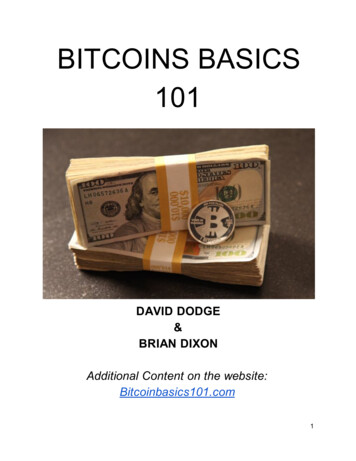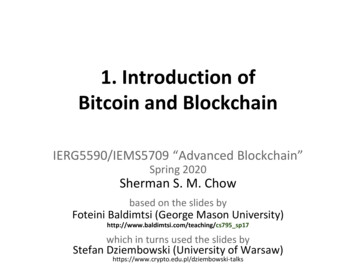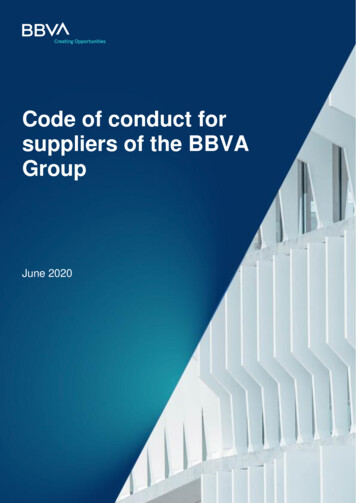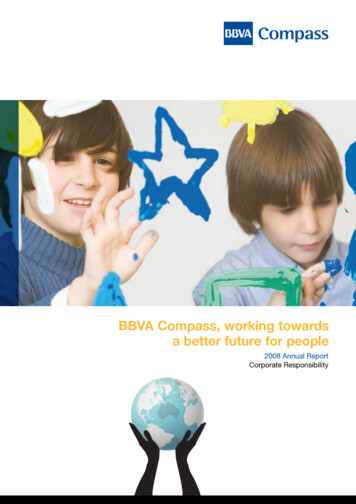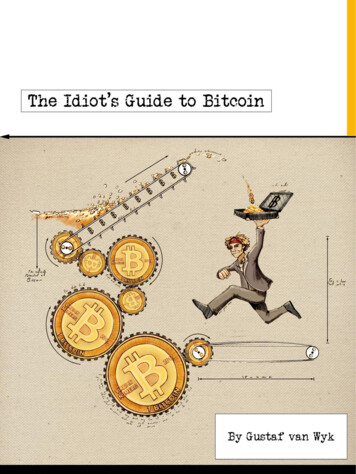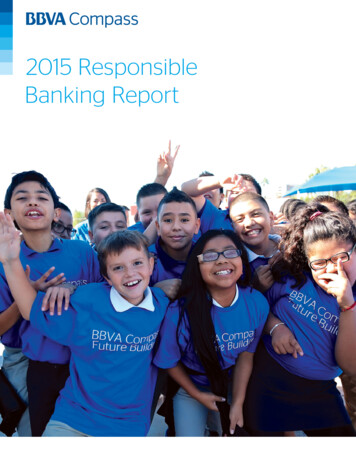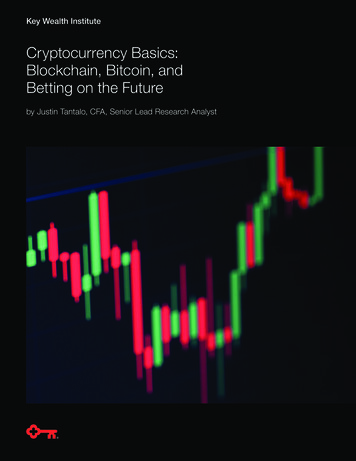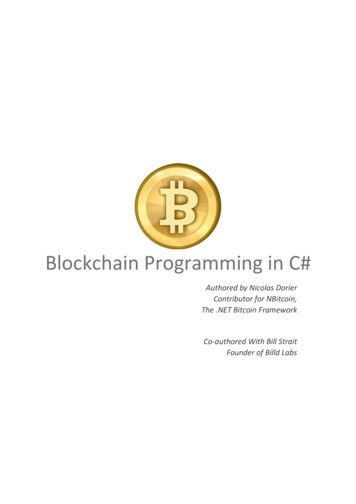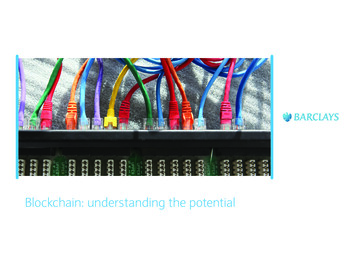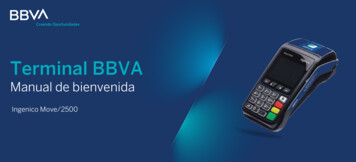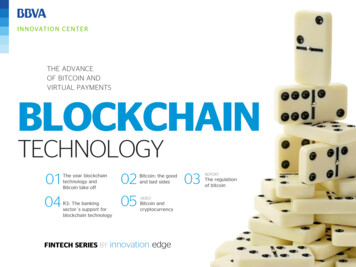
Transcription
THE ADVANCEOF BITCOIN ANDVIRTUAL PAYMENTSBLOCKCHAINTECHNOLOGY0104The year blockchaintechnology andBitcoin take offR3: The bankingsector s support forblockchain technologyFINTECH SERIES BY0205Bitcoin: the goodand bad sidesVIDEOBitcoin andcryptocurrencyinnovation edge03REPORTThe regulationof bitcoin
01The year blockchaintechnology andBitcoin take off?Little is known about the advance in thistechnology, as with Bitcoin –its strongestvirtual currency– which after a fewmonths immersed in scams andirregularities, is now recovering consumerconfidence.FINTECH SERIES · JANUARY 2016 · www.centrodeinnovacionbbva.com/en
Bitcoin is the most famous andthe strongest of the around700 virtual currenciescirculating on the Internet.Behind the currency lies thetechnology known asblockchain which –as definedby BBVA Research,“is a peerto-peer public accountingsystem maintained by meansof a distributed network ofcomputes which requires nocentral authority or thirdparties acting asintermediaries”.This technology “consists ofthree fundamentalcomponents: a transaction, atransaction register and asystem that verifies and storesthe transaction. The blocks aregenerated using open-codesoftware and registerinformation regarding whenand in what sequence thetransaction takes place. This"block" stores chronologicalinformation on all thetransactions taking place in thechain –the origin of the name"blockchain". In other words,blockchain is a stamped andimmutable hourly database ofeach transaction that isreplicated in servers aroundFINTECH SERIES · JANUARY 2016 · www.centrodeinnovacionbbva.com/enthe world. This technology isthe basis of Bitcoin, acryptographic currency”.
The mysteriousdisappearance of SatoshiNakamotoWhat distinguishes “normal”transactions is that they do notrequire an intermediary orcentralized entity, and thereforethe risk of human error isreduced. People who buyBitcoin on the Internet obtainan alphanumeric code –between 27 and 34 characters–which allows them to makepayments to other people whohave the electronic wallet.Bitcoin allows transactionsbetween users via P2P, theexchange of informationbetween equals, the samesystem used in the exchange ofmusic and film archives. In2008, according to Wikipedia,Satoshi Nakamoto published anarticle describing the BitcoinJanuary 2009 the P2P Bitcoinnetwork came on line with thepublication of the firstcustomer, code, and thecreation of the firstBitcoins.Curiously, SatoshiNakamoto today is on alljournalists' most wanted lists.After writing the article thatlaunched Bitcoin andexchanging mails on the virtualcurrency for two years withcolleagues, in 2011 hedisappeared. No one has everseen his face or heard hisvoice, and it is not even knownFINTECH SERIES · JANUARY 2016 · www.centrodeinnovacionbbva.com/enwhether his name is real orinvented. A mystery aboutwhich much has been written,and which has even found itsway into the world of comics(Bitcoin,the hunt for SatoshiNakamoto, by Alex Preukschat).Satoshi Nakamoto was the firstto “mine” Bitcoins. Back toBBVA Research: “When peoplebuy or sell Bitcoins, a secretcode or token is sent to thesystem.
The "miners" use nodes,computers, or devicesconnected to a network toidentify and validate thetransaction, using copies of allor some of the blockchaininformation. Before the networkaccepts the transaction, theminers have to show a "proof-ofwork" using a cryptographichash function: a specialalgorithm designed to providehigh levels of protection. Theminers receive some kind ofremuneration for theircontribution to computingpower, thus avoiding the needfor a centralized system”.Since its creation in 2009 thevirtual currency has grownrelentlessly. It is estimated thatinvestment in Bitcointechnologies is now worthFINTECH SERIES · JANUARY 2016 · www.centrodeinnovacionbbva.com/enalmost one billion dollars, andall the signs are that this figurewill continue growing. And thisinvestment comes not onlyfrom venture capital companies.Some of the financing rounds in2016 are predicted to exceed100 million dollars, according tothe financial consultantsMagister Advisors.
02Bitcoin: the good andbad sidesThe virtual currency is making a comebackafter a turbulent year. The InternationalMonetary Fund is giving it a vote ofconfidence and the banking sector isfocusing on its development.
You can't mention Blockchainwithout mentioning Bitcoin.The virtual currency is thesymbol of blockchaintechnology which aspires tochange payment systems.Bitcoin has been at the centerof scandals since was launchedin 2009, although proof of thefact that it is becomingstronger can be found in thefirst statement by theInternational Monetary Fundabout virtual currencies. Thestatement, made in January,says that “Virtual currenciesand their technology canprovide quicker and cheaperfinancial services which couldbecome a powerful tool to takefinancial inclusion further in adeveloping world”. Manypeople think that this is thetime when Bitcoin is enteringits mature phase after six-and-a-half years surrounded byirregularities and some fraudcases. Even the founder -whohas disappeared, who isfaceless whose name is even indoubt- of the virtual currencyhas been nominated for the2016 Nobel Prize inEconomics.He was nominated byAmerican economist BhagwanChowdhry who says thefollowing about the virtualcurrency founded by SatoshiNakamoto: "Bitcoin, whichexists purely as a mathematicalobject, offers many advantagesover both physical and papercurrencies. It is secure, relyingon almost unbreakablecryptographic code. Itbypasses governments, centralbanks and financialintermediaries such as Visa,FINTECH SERIES · JANUARY 2016 · www.centrodeinnovacionbbva.com/enMastercard, Paypal orcommercial banks eliminatingtime delays and transactionscosts."
Bhagwan Chowdhry alsopoints out that “the consumerswill be big beneficiaries andindeed the poor and marginalsections of the society will reapthe benefits of financial andsocial inclusion”.Bitcoin seems to be entering agolden age after quite a fewdark years. When it wascreated, the banking sectorwas very wary of it, whilerebellious geeks, cyberanarchists and followers of theanti- globalization movementembraced the virtual currency.They saw it as an anti-systemFINTECH SERIES · JANUARY 2016way of competing with thecapitalist model. It was also away of laundering money orcommitting tax evasion.andthis was evident in thefluctuations of the currency:in January 2013 it cost 13dollars, more than 1,000dollars nine months later,before falling again to 300dollars.
Support from BanksThe banking sector is currentlysupporting Blockchaintechnology. BBVA is part ofthe group of internationalbanks that are looking at whatthis technology could bring totheir business, and they haveplaced their trust in anAmerican startup, R3, todevelop applications using thistechnology in the financialsector.This project currently includesaround 30 global banks,including BBVA (whichfeatured among the foundersin September this year), Bankof America, Barclays, GoldmanSachs, HSBC, JP Morgan,Morgan Stanley, SociétéGénérale, BNP Paribas,Canadian Imperial Bank ofCommerce, ING,Commerzbank, UBS, andothers.Also at the beginning of 2015,BBVA invested in the largestwallet of virtualcryptocurrencies in the world,Coinbase, which includes anexchange service that allowsusers to buy and sell and then.FINTECH SERIES · JANUARY 2016 · www.centrodeinnovacionbbva.com/enBanks have arrived on thescene late, although they havecome to realize the revolutionthat is coming. This revolutiondoes not only affect payments.According to BBVA Research:“the greatest of a publicaccounting system could gobeyond payment systems.Because most financial assets,like bonds, securities,derivatives and loans arealready electronic, some daythe whole system could bereplaced by a decentralizedstructure. In fact, the mostrecent innovations use tokensto store and market assets likesecurities, bonds, motorvehicles, houses and staplefood commodities".
"The so-called "colored coins"carry additional informationabout the asset, whichgenerates a "smart property" orthe ability to record andconduct transactions withthese assets using "smartcontracts" via complexalgorithms through distributedplatforms without a centralizedlog, increasing their efficiency.In this regard, the currentsystem in which financialinstitutions record individuals'accounts in a centralizeddatabase and banks' reservesare stored in the central bank(for example, the FederalReserve) would be replaced bythe "Internet of money" or the"Internet of finance", a fullydecentralized financial system”.FINTECH SERIES · JANUARY 2016 · www.centrodeinnovacionbbva.com/en
03/REPORTThe regulationof BitcoinThere is a race to determine therules of the virtual currency. Butis it too soon? the consultancyfirm Deloitte wonders.FINTECH SERIES · JANUARY 2016 · www.centrodeinnovacionbbva.com/en
Bitcoin has captured theimagination of consumers andbusinesses around the worldas one of the greatestadvances in exchangingshares. Blockchain technologyhas been a major ITbreakthrough that seems tosolve what seemed unsolvable:ensuring that a digitaltransaction occurs only once.However, there is afundamental question thatlooms over Bitcoin, whichcould slow the pace ofinnovation and its adoption,and that is what its regulationwill be, as highlighted BY thisreport by Deloitte.There are three reasons, saysthe consultancy firm, why theauthorities and regulatorsshould consider delaying theregulation of Bitcoin, to givemore time and freedom toblockchain to explore its fullpotential. Deloitte emphasizesthe following points:1. Bitcoin is still very smallcompared to traditionaltransaction systems Bitcoinreceives considerable attentionand scrutiny from politiciansand regulators, far beyondwhat its current size and itsimpact on the market seem tojustify.FINTECH SERIES · JANUARY 2016 · www.centrodeinnovacionbbva.com/en
Currently, the total global valueof Bitcoins is less than US 4billion, which pales incomparison to the nearly US 1.36 trillion in circulation.Similarly, the penetration ofBitcoin in the market as amethod of payment is almostnil. With the power of theInternet, it's true that manyAmericans have heard ofBitcoin, but very few havebitcoins or used them for atransaction. Many of those fewusers are just experimentingwith the new technology, andnot necessarily as a method ofpayment for goods andservices.(US 700 million since 2014),we are far from actual productsthat could generate a realMoreover, while it's true thatventure capital investmentswith bitcoins in startups haveincreased a lot in the last yearFINTECH SERIES · JANUARY 2016 · www.centrodeinnovacionbbva.com/endemand for bitcoins relatedwith services to the generalpublic.
2. Other key innovationshad more time to developbefore being regulated.Looking back history ofinnovation, other technologiesthat have transformed oursociety had more time todevelop before being seriouslyregulated. Some notableexamples are the following:- Phone: invented in 1876,regulated in 1913 (37 yearslater).- Aircrafts: invented in 1903,regulated in 1938 (35 yearslater).- Radio: invented in 1907,regulated in 1927 (20 yearslater).- Cell phones: invented in1965, the first FCC wirelessspectrum bidding processfocused on mobile data in1989 (24 years later).- Internet: invented in 1969, ithas only become an area withintense regulatory focus inrecent years, nearly 46 yearsafter its development.The open code softwareprogram that is Bitcoin wasfirst launched in 2009. It hasonly been six years sinceBitcoin was developed that isvery far from the time inwhich other technologies wereadopted by the general publicin the past.
3. Other, more valuable andimportant, possible uses ofBitcoin have still to beinvented. Bitcoin abreakthrough that couldpotentially transform andimprove the way the publicaround the world carries outfinancial and non-financialtransactions. However, it ismuch more than digitalmoney. More broadly, theprotocol capacity of Bitcoin togive confidence to parties thatdo not know each other couldchange the way people liveand interact.banking services to the billionsof people living in the ThirdWorld, they are great ideas.The list of cases in whichBitcoin and blockchain canpotentially be used is growingevery day, and although it is inits infancy, some of itsemerging uses are veryinteresting. From allowingmore efficient bankingnetworks to providing theapplication that will promoteLike others before it, it is likelythat Bitcoin will move from oneinnovation to another, andfinally develop products,services and capabilitiespreviously unimaginable thatwill become needs in our dailylives.FINTECH SERIES · JANUARY 2016 · www.centrodeinnovacionbbva.com/en
Considerations for policymakers and regulatorsDeloitte argues that Bitcoinwas consciously designed tobe a source of digital currencyand open public accounting,beyond the control of anygovernment or company. Atleast on the surface, it lookslike Bitcoin and blockchainhave solved a major problemby allowing trade to evolvethrough the Internet, i.e. bymaking it possible to carry outpublicly-verifiable transactionswithout having to exchangeincreasingly- vulnerablepersonal financial information.It's a bold experiment.As Bitcoin aims to changesomething so fundamental toour economy and, ultimately,so important to our personallives, it may indeed causesome fear. However, inseeking to protect the publicfrom misuse, could policymakers and regulators noteventually drown from thepossible capabilities that couldpotentially change our life forthe better? In many ways it isthe classic challenge thatpolicy makers and regulatorsalways face: how to react tosomething that is so differentto what existed before?It's a difficult dilemma, but theactual market can provide thebest guidance on when andhow regulators should step in.On the one hand, innovationsFINTECH SERIES · JANUARY 2016 · www.centrodeinnovacionbbva.com/enare massively adopted only ifthey are useful and createvalue, and most of the timetheir greatest value appears inways never imagined beforeand we did not know wewanted or needed.On the other hand, if a newtechnology cannot reach thecritical masses, it oftendisappears as suddenly as itappeared. The same canhappen to Bitcoin. It's like the"chicken and egg", i.e. will theadoption of Bitcoin andblockchain drive the pace ofregulation, or will theregulation help to achievewider adoption?
What the future holds remainsto be seen, but some importantquestions remain, as with theInternet. Must the United Statesprovide the enablingenvironment for the incubationand maturation of Bitcoinrelated innovation? Or shouldwe wait and see the attitude ofothers and let them capturemost of the new value, whichcould be important in thecoming years? Given thepotential of this technology todisrupt both financial servicesand technology industries, it isdesirable that industry groupsas well as policy makers andregulators encouragecollaboration and dialog atnational level, the consultancyfirm concludes.FINTECH SERIES · JANUARY 2016 · www.centrodeinnovacionbbva.com/en
04R3: The banking sector's supportfor blockchain technologyThe New York startup –involving participation by some 30 banks– is testingblockchain technology in its interbank transactions.FINTECH SERIES · JANUARY 2016 · www.centrodeinnovacionbbva.com/en
The US startup R3 CEV hasmade a preliminary test ofinterbank transfers usingblockchain technologyblockchain, according toBusiness Insider. R3 thusbecomes the first collaborative“laboratory” for developingthese trials, and constitutes amilestone for thedevelopment of blockchain.The test focused mainly oninterbank transactions. Theparticipating banks simulatedthe exchange of shares inorder to explore theblockchain potential forinstant global transfers withoutthe need for an intermediary.R3 used the Ethereum andMicrosoft Azure technology, acloud computing platform.Eleven banks took part in theproject, among them Barclays,Commonwealth Bank ofAustralia, TD Bank and WellsFargo. BI Intelligencepredicted that in 2016blockchain technology wouldbe applied to interbanktransfers, and the first R3 testmarks an important step inthat direction.As reported in this article fromthe Financial Times publishedin the newspaper Expansión:“Blockchain has been hailed byadmirers as holding therevolutionary promise that theinternet did two decades ago.Business figures fromMicrosoft’s Bill Gates toRichard Branson have extolledits potential”. And it underlinesthat after the mistrust causedby the early scandals “almostFINTECH SERIES · JANUARY 2016 · www.centrodeinnovacionbbva.com/enevery big financial servicesinstitution has nowovercome that initialsuspicion. And thetechnology has swung frombeing a weapon wieldedagainst banks to beingheralded as their ultimateback-office makeover, a bitterblow to the libertarians whoconceived the idea of theblockchain to circumvent theglobal banking system. Suitsare replacing hoodies andripped jeans at blockchainconferences", says MarkBuitenhek, head of transactionservices at Dutch bank ING.According to the Britishnewspaper, the technology isalready handling aconsiderable volume ofbusiness.
On a normal day over120,000 transactions aremade through the bitcoinblockchain with a total value of75 million dollars, accordingto blockchain.info. Theregister now has 38,000blocks and almost 45gigabytes of information.Banks are focusing ononline channelsThe banking sector is clearlycommitment to blockchaintechnology. It is worth notingthat the shift from bankingbranches to online channelsand mobile devices has beenone of the dominant issuesfor large banks in the lastquarter of 2105, according toBusiness Insider. Today banksare continuing to cut back onstaff numbers in theirbranches: JP Morgan, forexample reduced its workforceby 12,000 employees in 2015(a reduction of 43,000 jobssince 2012), and it isestimated that Citibank plansto close as many as 50branches in the first quarter of2016, opting to focus on itssix most active markets.There is no doubt that digitalbanking is still growing at agood rate: JP Morgan itselfheads the market with almost23 million online bankingusers, up 20% over theprevious year.FINTECH SERIES · JANUARY 2016
Wells Fargo now has 16.2million users, after havingfollowed a practicallyhorizontal trend between thesecond and third quarters of2015. And finally, Bank ofAmerica today has 18.7million online banking users,up 13% over the previousyear. In fact, 15% of bankdeposits were made viacellphone, representing agrowth of three points overthe previous year.Digital banking is becomingone of the big banks' mostimportant tools for attractingand creating loyalty amongtheir customers.The mobile banking market isclose to saturation. Althoughthe number of digital bankingusers of the three main banksin the US continues to grow,it is doing so at a slower ratethan before. As a result,banks are starting to usedigital tools to create lastingrelationships with theircustomers. For example,Wells Fargo is investing inproducts and services thatincrease convenience forconsumers while improvingtheir customer service,building long-termrelationships with the users“for a lifetime”. Citibank alsowants to build deeperrelationships with itscustomers.SERIES FINTEHFINTECHSERIES· NOVIEMBRE· JANUARY 20162015· www.centrodeinnovacionbbva.com/en· www.centrodeinnovacionbbva.com
If they want to move forwardin that direction, banks willalmost certainly have to buildmore and ever more complexdigital services; in otherwords, once the vast majorityof banks offer "mobilebanking", it will becomeessential to offer exclusiveservices that set them apartfrom the competition andalso help build loyalty amongtheir customers. Oneexample is Bank of America,which began offering thechance to book appointmentsFINTECH SERIES · JANUARY 2016 · www.centrodeinnovacionbbva.com/enthrough its app. This type ofservices which contribute animportant added value willgradually evolve in the future,in fields such as consulting orloans.
05/VIDEOBitcoin ycryptocurrencyDiscover all the possibilities that therise of bitcoin and cryptocurrencyentails. We explain how they work inthis video.VIDEOFINTECH SERIES · JANUARY 2016 · www.centrodeinnovacionbbva.com/en
shareLASTEST ISSUESFINTECHSERIES BYinnovation edgeBBVA Innovation Centercreates the Fintech Series ByInnovation Edge to keep youinformed about the financialinnovation trends with itsmilestones, analysis, casesstudies, interviews withexperts and infographics todisplay the data that describeeach of these trends.The takeoff of emergingcompanies in a competitiveworldEasy, quickly and very efficiently arethe keys of personal managementtools (PFM)A new concept in the world ofStartupsA new model of payment: Therevolution of virtual wallets
Follow us:Registerto keep up withthe lastest ionbbva.com/innovation-edge/enBBVA no se hace responsable de las opiniones publicadas en este documento.
You can't mention Blockchain without mentioning Bitcoin. The virtual currency is the symbol of blockchain technology which aspires to change payment systems. Bitcoin has been at the center of scandals since was launched in 2009, although proof of the fact that it is bec
